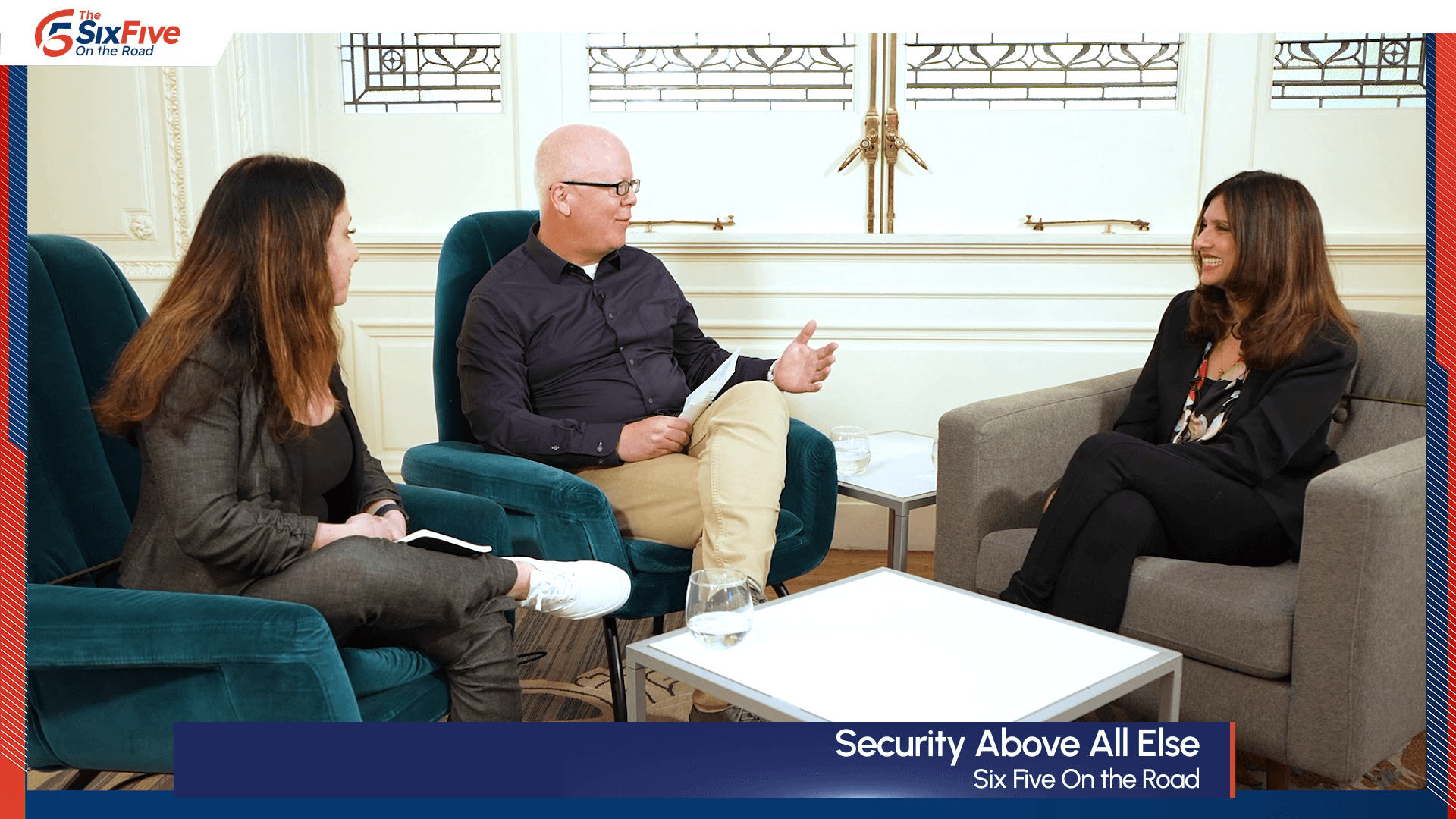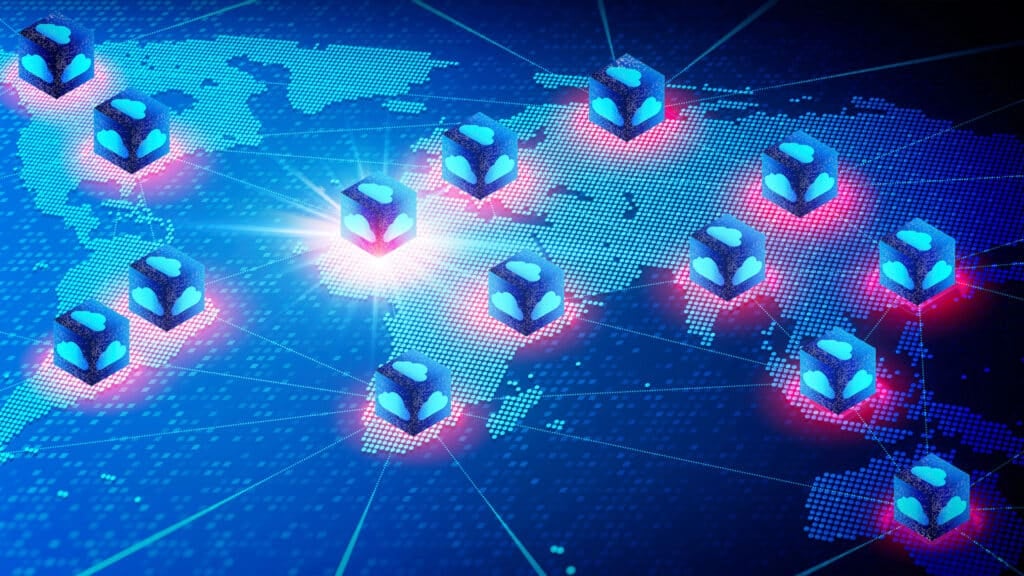On this episode of the Six Five on the Road, Krista Macomber and Will Townsend are joined by Microsoft‘s Vasu Jakkal, Corporate Vice President, Microsoft Security for a conversation on Microsoft’s unwavering commitment to security.
Their discussion covers:
- Microsoft’s expanded Secure Future Initiative and its approach to security
- Insights from the deployment of Microsoft Copilot for Security and its impact from a customer perspective
- The role of GenAI in the realm of cybersecurity, examining both threats and defenses
- The concept of “security as a team sport” and Microsoft’s strategy in fostering robust security ecosystems
Learn more at Microsoft.
Watch the video below, and be sure to subscribe to our YouTube channel, so you never miss an episode.
Or listen to the audio here:
Disclaimer: The Six Five Webcast is for information and entertainment purposes only. Over the course of this webcast, we may talk about companies that are publicly traded and we may even reference that fact and their equity share price, but please do not take anything that we say as a recommendation about what you should do with your investment dollars. We are not investment advisors and we ask that you do not treat us as such.
Transcript:
Will Townsend: Krista and I are speaking with Microsoft again as we take The Six Five On the Road to RSA conference 2024. You and I had a great conversation with executives in New York back in March when Microsoft announced general availability for Copilot for Security. And we’re joined again by Vasu Jakkal. She’s the corporate vice president for Microsoft security business. Vasu, It’s so great to see you again.
Vasu Jakkal: Oh, it’s great to be here with you both. Thank you so much for having me.
Will Townsend: Well, and she and I both attended the pre-event yesterday. I just want to say I thought that was a fantastic way to kick off the week for you and Charlie Bell, who’s the executive VP for the business to speak to what you’re doing, how you’re bringing that flywheel of innovation from Microsoft into focus, how that’s basically providing customers with a consolidated opportunity to manage all their security. But I want to talk about the Secure Future Initiative.
And this is something that you announced back in November of last year. On Friday of last week, there were some new announcements. Krista and I both wrote about that on LinkedIn as well. And I’m super impressed with the fact that now Microsoft is going to prioritize security over new features. And that’s a huge challenge. And that really speaks to the commitment that you are making when it comes to security. But let’s talk about SFI, and I know there are pillars around that and the philosophy. We’d love to hear more about that.
Vasu Jakkal: Yeah, absolutely. And just to start with, just thank you for being great partners on this journey. We are big believers as you know at Microsoft that security is a team sport. And our Secure Future Initiative also underscores the importance of that team sport. I’m very proud of the commitments that we’ve made. And we live in sobering times. You step back and you look at the threat landscape and the speed, the scale, the investigation of attacks is rapidly escalating. Every time I sit down with you, and I use the word unprecedented, I feel the next time I meet you, I said, it’s unprecedented. Tomorrow’s going to be unprecedented again.
And so, we are facing adversaries who are well resourced, who are incredibly sophisticated, who are patient, who are persistent, they’re relentless. And we live in a very different world. And the age of AI, which holds so much promise for elevating the human potential, we need to make sure that to really, really leverage that, we start with cyber security. In November last year, we announced Secure Future Initiative to really figure out how do we protect in this age of AI. What are the things we need to do like secure by design and secure by default. And since then as we have faced another really challenging threat landscape, as you’ve seen even with Midnight Blizzard and others, it was time for us to really double down on Secure Future Initiative. And that’s what Satya’s memo to every single employee at Microsoft was about. That’s what Charlie outlined his blog.
So, the Secure Future Initiative, it has three principles at its heart. Secure by design. So, everything we do, every line of code we writet needs to be secure by design. Secure by default. It’s not a choice. You’ve got to have security enforced, and you’ve got to have it as default, and you’ve got to remove the friction from the process and secure operations. You’ve got to continuously have the secure operations. It’s based on this principles of continuous improvement and pave paths. And then there are six pillars of Secure Future Initiative because we looked at it and we’ll continue to evolve that. But we started with what are the key things that we need to do? What are the things we need to invest in? What are the things that every employee should be thinking about?
We have secure tenants because that’s where we need to really focus our energy. We need to make sure that every tenant, no matter if it’s a test, tenant to production, tenant to demo tenant is secure. We need to isolate production systems identities. Identity continues to be the battleground of security. Secure identities and secrets. Secure engineering systems as you’re developing code, as you’re designing code, as you’re running code to make sure you’re securing networks, monitoring and detecting threats continuously. And then the last one is really increasing or accelerating our response and remediation. So, those are the six pillars of Secure Future Initiative. And there’s a lot of detail that we’ve published and we’ll continue to make sure that we keep everyone updated on the progress.
Will Townsend: I think it’s really an innovative approach and it’s from my perspective, it’s a blueprint that any organization can adopt. Krista, your thoughts.
Krista Macomber: Yeah, absolutely. And I think Vasu, one thing that jumped out to me as well regarding the announcement was as you mentioned, baking security in fundamentally across the products, but also really making sure that it’s infused at the core of Microsoft culture as well. And I think that’s really important because the technology carries us far, but we really need to make sure that all of our people and our processes on board as well. And I believe there’s going to be a deputy CISO it sounds like installed across the product line. So, any commentary on that? Because that was, I thought, really interesting.
Vasu Jakkal: No, absolutely. Because security is not just a technology challenge, it’s a human challenge. It’s a societal challenge. It’s a culture challenge. And so, there are definitely technology advancements that we are making and we are going to make and we all need to do. But there’s also governance-related things. There’s how we hire, how we reward people, what are the structures we are going to put in place-
Will Townsend: There’s compensation type as well.
Vasu Jakkal: Compensation type to it. These are all, I’d call it them cultural attributes to make sure that security is foundational. And as you started with, Satya made this our number one priority, security above all else, above all else features. And so, for that, we have looked at how do we do governance? How do we operate as a company to make that security the heartbeat of the company? How do we reward? How do we hire? And what’s the governance structure that we want to put in place? So the deputy CISOs a great example where we are going to have deputy CISOs for every product line. And then we have engineering leaders for all of the pillars that I talked about. And then we have virtual teams that we are working daily, weekly with oversight from our CEO, our SLT, and of course our board as well.
Krista Macomber: Yep, absolutely. And maybe just to circle back a little bit to the Microsoft portfolio and the work that we did together back in March. So, I know when we last met, as Will was alluding to, it was the JA of Microsoft Copilot for Security. So, just would love to catch up with you regarding customer reception. And also really how are customers really implementing Copilot for Security as a part of their day-to-day operations, really when the rubber hits the road.
Vasu Jakkal: Yeah, no, absolutely. I do believe, as you both know and we’ve talked about, the age of AI holds a lot of promise, especially for security. Security is going to be one of the best use cases for generative AI and definitely the most serious use case. I mean, look at what’s going around in the world today. Cybercrime is costing our world trillions of dollars. The number of password attacks per second is 4,000 password attacks per second. We look at how long it takes for an attacker to get access to data. On average 72 minutes from an user clicks on a phishing link for an attacker to get access to that data. So, there just isn’t buying enough time for defenders to respond.
And this is where generative AI is going to make a big difference because it defends that machine scale and speed. And then we have the talent shortage. And I know you both are really passionate about the 4 million jobs unfulfilled. Well, how are we going to tilt the balance in favor of defenders if we don’t do something fundamentally different? And that’s what Copilot for Security is about. In my lifetime, I believe this is going to be one of the most consequential technologies that I’m going to work with and I’m really, really excited. So, we announced general availability when I was with you last time in New York. General availability started April 1st. We also wanted to make sure that Copilot for Security is a tool that everyone can use. We had this ethos at Microsoft Security for all.
No matter where you’re on your journey, no matter who you are, no matter where you are, you should be able to use that because we want to include a whole world as we develop that. So, we made the pricing model also very, I hope, lucrative for people to use. You can get started, it’s consumptive. You can pay for what you use. And what we are seeing is all of these combined, the product, the way we’ve priced, the way we’ve packaged, the way we are going to market, has really helped all organizations embrace Copilot for Security. We continue to see tremendous demand. We have hundreds of customers since we announced general availability who are using Copilot for Security. We had hundreds of customers in our early access program. And now as they are coming to the end of their early access program, we are seeing them convert and start using the generally available Copilot for Security.
And we started with four use cases, which was related to security operations. We see progress on that. We see customers using that with thousands of active users for that. And we are going to continue to build more skills like identity and data security, and integrate Copilot into every single product that we have, as well as make sure that as customers use this technology, they can add their own knowledge bases to it and they can add their own integrations to it.
Will Townsend: I believe one of Copilot for Security superpowers is that onboarding capability. And I think you touched on this at the pre-event yesterday, because there’s this shortage of professionals in the industry, and you’re needing to bring in new people, and you need to get them on-ramp very quickly. And why don’t you talk to the statistic that you shared. It was around the tests that you did with providing Copilot to one group and not to the other. And what were the results? They were pretty impressive.
Vasu Jakkal: We have been doing studies to understand the effectiveness of Copilot for Security. And again, it’s the idea behind it, is how do we create learning loops for feedback? And how do we really develop technology which makes defenders’ lives easier? So, we ran some studies, research studies with defenders and we ran them with different sets of people. First we started with early in career. So, security professionals who are just starting their journey or who may not be very familiar with security. We also did it with advanced security professionals and the results were outstanding.
So, for early in career security professionals, we saw that they were 26% faster if they used Copilot for Security. They were 35% more accurate. But my favorite statistic, I call it the joy factor, I don’t know what else to call it, because how many times do we see technology and we’re like, “Oh my goodness, the security product is so amazing to use. I’m feeling such joy out of this.” It’s not- very rare.
Will Townsend: That’s usually not the case.
Vasu Jakkal: It’s very rare, right?
Krista Macomber: Exactly.
Vasu Jakkal: But they loved using co part of a security. 97% of people want to use it again. That to me is pretty remarkable. And then on the other side, we tested it with advanced security professionals. They were 22% faster. Sorry, the early in career were 26% faster. So, the advanced were 22% faster and they were 7% more accurate, which is also incredible. And again, 97% of people wanted to use it again. So, this tells me that we have a technology which is going to bring that simplicity. It’s going to remove that drudgery from the everyday of security professionals. Because ultimately, we want people to do what they do best creativity and ingenuity to… I don’t know. We face all these attacks that are coming our way, not spend time doing all of the stuff that technology can take care of you. So, that’s what gives me a lot of heart. And those are some, I think, very powerful results that we’ve got from Copilot for Security.
Krista Macomber: Vasu, building on that concept of security, you got a great question yesterday evening in the analyst session that I just had to bring back up because I thought the answer was so fantastic. And it was around this concept of customers potentially putting all or more of their eggs in one basket with Microsoft. Because we do see just that network of security tools is very vast. I heard from one customer, 40 tools, they actually were able to consolidate down to over 25. And even that is still, practically speaking, very unmanageable. So, can you talk a little bit about, as Microsoft not only uses AI but also brings this comprehensive set of capabilities to the table, maybe what are some of the feedback? How do you envision customers moving forward under a little bit more of a consolidated umbrella, if you will, from the security?
Vasu Jakkal: Yeah, absolutely. And to answer that, I’ll start with why Microsoft believes an end-to-end platform. It starts along with all the challenges that we just talked about, threat landscape, talent shortage. There’s also huge fragmentation in the tool ecosystem. It’s really, really hard because we are expecting organizations, and defenders, and security teams to stitch together these tools. So, you have an elevated threat landscape, you do not have the talent you need, and you have to stitch together all these tools. That doesn’t seem like success to me. And that’s what our customers are facing today.
So, when we started on this journey with Microsoft security, we looked at what are the challenges that our customers are facing? We saw challenges in threat landscape, and that’s why one of our biggest core pillars of investment is threat intelligence. Today we process 78 trillion signals every single thing.
Will Townsend: That number blows my mind. And I was going to bring it up. I’m glad you brought it up.
Vasu Jakkal: Doesn’t it?
Will Townsend: Yeah.
Vasu Jakkal: When I joined Microsoft in 2020, we were processing 8 trillion signals every day. I thought that was a lot. But we really invested in that 78 trillions, almost 10x.
Krista Macomber: I wrote it down yesterday and I was like, “Did I write that down?”
Will Townsend: Is that number off by a factor of time?
Vasu Jakkal: Isn’t that incredible? We’ve invested in that. And we also have human intelligence which tracks more than 300 plus unique nation-state and financial crime actors. So, we started with the threat landscape because you cannot protect what you cannot see.
Will Townsend: Sure.
Vasu Jakkal: That intelligence then grounds all our technologies, which comes to the vendor fragmentation. So, we looked at the other challenge, talent shortage, vendor fragmentation. And we said we want to make it easy for our customers. Today we integrate more than 50 categories and we bring it to life in one end-to-end platform. We have six product lines, defender and sentinel threat protection, purview and prevar, data security, governance, compliance and privacy. Because that matters a lot. And we can talk endlessly about that. That’s one of my favorite-
Will Townsend: Especially identity.
Vasu Jakkal: Yeah, exactly. And identity and access with Entra and Intune. Now we also took a platform approach because we understand that customers are in various stages of their journey. So, we wanted it to be easy for them to integrate their tools, third-party tools into the platform. And then the last one we looked at, we talked about generative AI because we’re like, how do we just really accelerate this flywheel of innovation? The threat intelligence feeds these products, threat intelligence feeds that AI and we need to go fast and defend at machine’s speed and scale.
So, now coming back to your question on the, “Hey, should I bet on Microsoft?” Well, people are already betting on Microsoft. Today we have a million customers who are using million-plus Microsoft security technologies. We have more than 700,000 customers who are using four or more solutions. And if you look at them, and if you ask them, they said, “For us, it’s really important to have a company that understands technology and understands security.” And if you look at Microsoft, what is our unique seat at the table? We are a software company and we are a security company. We have so many endpoints in the world vendors.
So, we understand how operating systems are built, how endpoints are built. We started with identity, identity systems at Entra. So, we understand deeply how identity is built. And we bring all that knowledge to the table. So, more and more customers are seeing that vantage point and they want a vendor who is with them in this journey, who starts with wherever they at, and who reduces this fragmentation for them. So, while there are definitely hypotheses out there on what to do, and what not to do, and what to be. What we are seeing from our standpoint is we want more customers choosing Microsoft security because of our platform approved, because it gives them peace of mind, because it reduces fragmentation for them.
Will Townsend: And it’s to manage at the end of the day. I mean the statistic that I read a year ago was an average mid-market sized company is managing a 100 different security point solutions. That’s untenable. And at some point, you’ve got to consolidate. And I’m seeing that as an analyst, and I’m sure, Krista, you are as well, that there’s this movement from best of breed back to consolidation. Now, I don’t think one platform will be all things to all people that would be Nirvana. But I think we can get closer there.
Krista Macomber: Correct. Yeah. There’s no true silver bullet, but absolutely. I think at least taking steps to make some consolidation. Every little bit is going to help.
Vasu Jakkal: And to your point, this high ROI, the return of investment on a consolidated stack is much better than if you have fragmented stack. You might look at one technology and say, okay, the consolidated stack is more expensive. But when you actually add up all the technologies you would need to be at par, you get great savings. I’ll just give statistics that I have seen. If you use a Microsoft security stack today, we give you 60% savings over what a third party, like different tools that you would need to pull together.
And I think customers are looking at all of this. They’re looking at better threat protection because you don’t have silos. And remember, it isn’t those silos that you love. You get better ROI because you are getting cost savings. And then because of the talent shortage, you don’t need as many people to stitch together all these tools. The company, the vendor is providing that for you. So, I think there’s just better economics as well. And then lastly, I’ll touch on the best of breed. I think customers should get both best of breed and best of platform or best of suite. And that’s been a huge focus. I’m super grateful that we have invested to become best of breed across our portfolio. Today, Microsoft is a leader in 18 analyst reports. I think by far the most number of analyst reports.
And we hold the analyst point of view like yours very high on when we think about what’s the gold standard. So, whether it’s Gartner, IDC, or Forrester, whether it’s endpoint or identities, or data security, we are the leader in all these domains. So, we want to give our customers. We start with our customers, we end with our customers, and we use partners for that journey. And we want to give our customers great value, great protection. We want them to have best of breed, we want them to have best of suite, best of platform. And that’s been our deep commitment and focus.
Will Townsend: Yeah, that’s been very evident. Vasu, I’d like to go back to something that we talked about in March in New York. This whole notion around generative AI and how it can be a double-edged sword, and it can benefit defenders, but it can also be used by bad actors as well. And certainly, the threat intelligence that Microsoft’s able to bring to bear is impressive. And that’s got to help. But what else is Microsoft doing to help organizations defend themselves? Because it’s just an ever-changing landscape. I mean, these bad actors get smarter and more aggressive. And there’s more to it than just threat intel, right?
Vasu Jakkal: Absolutely. So, like every tool, attackers are going to use every tool at their disposal to you know for malicious intent. And we release some research with OpenAI on what attackers are using what we are seeing, like nation-state attackers. We released our cyber signal addition focused on how we are seeing generative AI being used by nation-state attackers. And they’re using it to become more productive. But we have to focus in addition to threat intelligence. What we are doing is A, first, it starts with just understanding what these attackers are doing and having that threat intelligence. But then we have a blueprint where we think about, you’ve got to discover, you’ve got to protect, and you’ve got to govern.
And with discover first you have to know what the apps are that are being used by your employees. Because securing AI and governing AI is going to be critical for us to use AI for all of these opportunities that we see. When you start by understanding, okay, what are the tools that my organization is using? Because people are going to use these tools, they’re going to use all kinds of tools. And this is where we invested in defender as an example, and specifically defender for cloud apps to understand, let’s start with understanding what’s the AI footprint, what AI apps are being used, how much of these AI apps are being used, and then are there any risky apps that the organization should know of because maybe they’re malicious actors using those apps.
Will Townsend: Or the orphaned apps, too. I think you talked about that. Yes.
Vasu Jakkal: Totally. What is not managed? The whole concept of shadow IT coming back with shadow AI, right?
Will Townsend: Yeah.
Vasu Jakkal: And so, how do we make sure that that’s not happening? And you can block it if you want. Then the second part is going to protect. Okay, how do you protect? One of the biggest challenges is data. Data which is flowing in, flowing out. If data is not labeled correctly as an example, and an employee uses tools and that data that he’s not or she’s not supposed to have surfaces up, that can be a huge challenge for an IP from sensitivity. So, making sure that your data is protected and that the AI tools are very aware of what data they should use and not is another important part of it. We also have to think about all the new attack surfaces that are going to be introduced. We’ve talked about traditional attack surfaces like identities, and endpoints, and network.
But when you think of generative AI, now you have prompts, you have LLM models. So, you have to think about all these new attack surfaces that are introduced and how are you protecting them? So, we put a lot of focus in our responsible AI framework as an example. And really thinking about from prompts, to LLM models, to content, what are the controls that we need to have? How do we decide, really build this trust architecture? And then lastly, you have to govern. There’s so many AI regulations now coming up. Are you compliant? These AI regulations? Are you making sure that you have the right governance around this AI regulations as well as the usage of AI?
So, I think it’s a multidimensional. Even as I’m talking, it’s multidimensional. And we have so many learnings from the last 50, a 100 years of how we use technology. Gosh, we have to use those learnings and we have to make sure that we design AI. And the last thing I’ll say, because this is super passionate about this diversity and inclusion, we have to make sure that AI is built by all, is used by all. Because otherwise, we are not going to have all these perspectives helping us build one of the most powerful technologies that we have.
Will Townsend: For sure. I know Krista has got one more question, but I’ve got a comment on something. I saw your LinkedIn post and you posted a Yoda quote. I’m a huge Star Wars nerd. And basically the quote that you spoke to was basically, failure is the greatest teacher.
Vasu Jakkal: Absolutely.
Will Townsend: And I like the whole try, try not. Do, do not. There is no try.
Vasu Jakkal: Totally.
Will Townsend: So, I’m putting my Star Wars nerd amount there. But getting back to the point that you made around just learnings. I mean, sometimes we have to fail. And certainly along this journey, it’s been a little bit bumpy for Microsoft. But you’re taking those learnings and you’re improving what you’re doing for your customers.
Vasu Jakkal: Absolutely. And our heart, and our focus, and our commitment is to, from a security standpoint, build a safer world for all. Our heart, and our commitment, and a focus from a Microsoft standpoint is to empower every person and organization in the world to achieve more. I think that’s a mission worth fighting for and worth living for.
Will Townsend: Oh, it’s noble.
Vasu Jakkal: And we’ve got to learn. All of the Secure Future Initiative, it’s hard work. We are going to learn from it, and that’s going to help us build best practices, better tools, better technologies. It’s going to help us advance our flywheel for innovation. And we’re going to do it, we are going to show up, we are going to do it, and we are going to ask all of you, our customers, our partners, to hold us accountable to that. So, I am inspired and I’m grateful for the opportunity to do that. And I love science fiction. I love Star Wars.
Will Townsend: That’s good to know.
Vasu Jakkal: I love Star Trek.
Will Townsend: That’s good to know.
Vasu Jakkal: So, I’m all about that. I grew up with Star Trek. I’m in technology because of Star Trek. But yeah, failure is the greatest teacher. And I think every obstacle that we face in life helps us learn something about ourselves and what we need to do.
Will Townsend: Absolutely.
Krista Macomber: Absolutely. And it’s a very optimistic take and it’s very refreshing because I think we do tend to hear so much about just how overwhelming the attack landscape is. And I think it really fits in with the theme here at RSA or the Art of the Possible, and collaborating together to overcome some of these hurdles, and encounter some of these struggles, and work through them together. So, on that note, there is the adage that security is a team sport.
Vasu Jakkal: Yes.
Will Townsend: You like to say that quite often.
Krista Macomber: And we hear, I think in many different quarters of the industry. So, I wanted to maybe peel that metaphorical onion back a little bit and ask you from your perspective, what does that mean, both from the Microsoft perspective, but also from the customer perspective as well?
Vasu Jakkal: Yeah, thank you for asking that question. It is my favorite thing. Because I’ll start with an African proverb that I absolutely love. I love quotes by the way. So, you’ll love quotes for me. And it is, “ if you want to go fast, go alone. But if you want to go further, go together.” And I’ll add to that quote, I’ll say further is better. It’s more fun, it’s more joyful. It’s lonely. And I’m a big believer in purpose, in that we are here to do something hopefully impactful and leave the world a little bit better in our own way. And for that, we need a great village. We need a great team.
And that’s why team sport is at the heart of how we do Microsoft security, because we can’t do it alone. And we don’t want to do it alone. We want to do it together with everyone. And so, we are investing in that, because we are focused on that. Let’s start with our Microsoft Intelligence Security Association or MISA, which is a community of partners who build on our solutions, who take our solution to market. So, we work with them. We have now 300 plus partners in that ecosystem. We work with 15,000 partners across the globe just on our technologies. And then the million plus customers that we have, we view them as just trusted advisors and co-creators. When we started with Copilot for Security, we took a very different approach to product innovation. Going back to our Yoda quote. How do we learn through the product?
So, we are asking our customers to give us feedback through that product. We are investing in open source technologies, we’re investing in security technologies. We just made a commitment to the Russ Foundation, commitment to the Alpha Omega Foundation. So, we want to invest in the communities as well. And then we are putting a lot of tools out there to help others with our technologies, but also for us to learn from them. So, we are investing in community colleges to make sure that we are making everyone who wants to be in security a defender. We are investing in skills and learnings. And we are inviting, at least I hope, a lot of organizations to partner with us on this journey together.
So, I’m excited about what we can do together. Because in this new age of AI, where I think we can dream a little bit bigger and wider, and do amazing thing, won’t it be amazing to do this together? We just think it’s going to be fun. And we have to do that, and we have to make sure that security is at the heart of it, that we approach it with a diverse perspective. By the way, that’s why it’s also a team sport, because only when we have different perspectives, we have cognitive diversity on what we need to do. That’s what a team looks like, right? So, I’m excited because we can talk more about team sport endlessly, but it’s one of the most important things I feel in security.
Will Townsend: I think so, too. And I think it’s a great way to enter a conversation. Vasu, we really always enjoy having these chats with you. I learned something new every time as well. I just want to thank you for spending time again with Six Five Media On the Road. And we wish you just a great RSA conference 2024.
Vasu Jakkal: Oh, thank you so much. I’m so grateful to you both. And I’m so grateful that you both lead with optimism, and hope, and light, and abundance because we certainly need that in security. And I look forward to an amazing journey.
Krista Macomber: Look forward to it as well. Thank you.
Will Townsend: Yeah, thank you.
Author Information
Krista Case is Research Director, Cybersecurity & Resilience at The Futurum Group. She brings approximately 15 years of experience providing research and advisory services and creating thought leadership content. Her vantage point spans technology and vendor portfolio developments; customer buying behavior trends; and vendor ecosystems, go-to-market positioning, and business models. Her work has appeared in major publications including eWeek, TechTarget and The Register.
Prior to joining The Futurum Group, Krista led the data protection practice for Evaluator Group and the data center practice of analyst firm Technology Business Research. She also created articles, product analyses, and blogs on all things storage and data protection and management for analyst firm Storage Switzerland and led market intelligence initiatives for media company TechTarget.
Six Five Media is a joint venture of two top-ranked analyst firms, The Futurum Group and Moor Insights & Strategy. Six Five provides high-quality, insightful, and credible analyses of the tech landscape in video format. Our team of analysts sit with the world’s most respected leaders and professionals to discuss all things technology with a focus on digital transformation and innovation.










